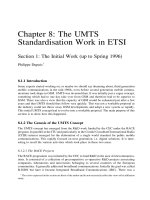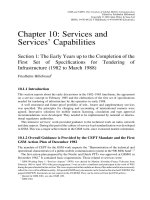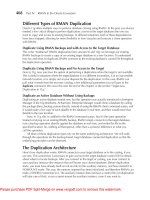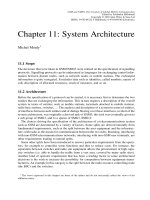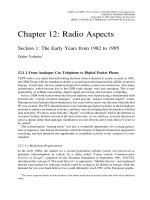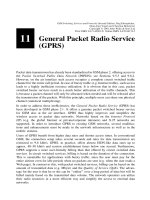GSM and UMTS (P11)
Bạn đang xem bản rút gọn của tài liệu. Xem và tải ngay bản đầy đủ của tài liệu tại đây (54.02 KB, 8 trang )
Chapter 11: System Architecture
Michel Mouly
1
11.1 Scope
The decisions that were taken in GSM3/SMG3 were centred on the specification of signalling
protocols. Signalling protocols can be understood as languages for exchanging control infor-
mation between distant nodes, such as network nodes or mobile stations. The exchanged
information is quite variegated. It includes data such as identities, called numbers, nature of
call, description of allocated resources, result of measures, and so on.
11.2 Architecture
Before the specification of a protocol can be started, it is necessary first to determine the two
entities that are exchanging the information. This in turn requires a description of the overall
system in terms of entities, such as mobile stations, terminals attached to mobile stations,
radio base stations, switches, … The analysis and description of a system in terms of entities,
of interfaces between such entities and of dialogs flowing over these interfaces, in short of the
system architecture, was originally a derived task of GSM3; this task was eventually given to
a sub-group of SMG3, and to a spawn of SMG3, SMG12.
The choices driving the specification of the architecture of a telecommunications system
such as GSM are determined by a variety of factors. Some splits are derived naturally from
fundamental requirements, such as the split between the user equipment and the infrastruc-
ture, with radio as the means for communication between the two sides. Roaming, interfacing
with non-GSM telecommunications networks, interfacing with non-GSM user terminals, are
other requirements leading to natural splits.
Some other splits have been introduced to answer particular requirements from the opera-
tors, for example to centralise some functions and thus to reduce costs. For instance, the
separation between switches and radio site equipment allows the procurement of high capa-
city switches (i.e. able to handle the traffic from a vast area, covered by many radio sites).
Another kind of operator requirement that has been a leading factor in some architectural
decisions is the wish to increase the possibility for competition between equipment manu-
facturers. An example in this category is the split between the radio resource controlling node
(the BSC) and the switches.
1
The views expressed in this chapter are those of the author and do not necessarily reflect the views of his
affiliation entity.
GSM and UMTS: The Creation of Global Mobile Communication
Edited by Friedhelm Hillebrand
Copyright q 2001 John Wiley & Sons Ltd
ISBNs: 0-470-84322-5 (Hardback); 0-470-845546 (Electronic)
Finally, many architecture decisions arose from the progressive enhancement of GSM past
the first phase. Adding new functions was in some cases done by introducing new nodes, to
ease manufacturing and/or deployment.
On the other hand, splitting a system, which has a unique goal (allowing end users to
communicate), in distinct and often distant entities leads to needs for co-ordination of the
actions of these entities so that the common goal can be achieved. The additional require-
ment to allow different manufacturers to compete on the equipment market (both for
infrastructure and for user equipment), as well as giving some level of independence
between operators, leads to the need for common, publicly available, specifications of the
key protocols ruling the communications between distant entities determined by the archi-
tectural choices.
This sums up the main activities of SMG3/SMG12: to choose and to describe the general
system architecture, to decide for which of the interfaces so determined a set of standard
protocols should be produced, and to specify among those protocols the signalling ones.
11.3 General Trends
The a posteriori analysis of the decisions taken by GSM3 distinguishes between two main
approaches: on one side the adoption and, if needed, adaptation of techniques and protocols
existing in the non-mobile telecommunications world, and on the other side the creation of
original solutions, usually to answer problems specific to mobile telecommunications. If the
latter approach illustrates the pioneering work and creativity of SMG3, the former has shaped
more fundamentally the design of GSM.
GSM was not designed independently from the rest of telecommunications. On the
contrary, the services provided by GSM are primarily an extension to mobile users of the
services available to users accessing networks through wirelines. For this reason, the tech-
nical choices made in wireline telecommunications have had a deep influence on most key
technical choices in GSM.
Two periods can be distinguished when looked at from the wireline point of view. The
initial, foundation building, technical decisions for GSM were taken around 1985–1988, at a
time when the telecommunications ‘‘ paradigm’’ was ISDN, characterised by integration of
voice and data, digital transmission of voice, and packet transmission for signalling. The
second period started around 1992–1993 and was full-blown around 1995, and corresponded
to the shift to all-packet transmission, with a focus on the Internet.
The areas where SMG3 has been the most creative were, not astonishingly, those where
no on-the-shelf solution was available from wireline techniques. From a signalling and
architectural point of view, the essential difference between cellular access such as in
GSM and wireline access is that a given user is not tied to a single access point, but on
the contrary, is allowed to access from many points, spread geographically at the scale of
the world, and from an administrative point of view, between many operators. This ‘‘ roam-
ing’’ capability has a very important impact on how to route calls towards users, since their
location is known only imperfectly. Mobility during calls leads to dynamic routing modi-
fications, the handovers.
For all these points, and many others, SMG3 built on the experience gained in NMT and
other first generation cellular networks, using original ideas from its members to set down
principles for digital cellular networks that remain valid through the next generation.
GSM and UMTS: The Creation of Global Mobile Communication302
11.4 Historical Perspective
11.4.1 Before 1985
The examination of the reports and participant lists of the GSM meetings in those first years
shows that the topics that were to be those of GSM3 were rather marginal. The main
advocate of those topics, and of their importance, was Jan Audestad, who was to become
the first chairman of GSM3. Important guidelines were established, if not officially, during
this period, in particular the idea that GSM was to be designed mainly to interwork with
ISDN.
11.4.2 1985–1988
GSM3 was created officially in 1985, in the first batch of creation of technical sub-commit-
tees of the GSM standardisation group. Activities related to network architecture and proto-
cols had started some months ago, as part of the GSM meetings, and the newly acquired
independence allowed the working pace to increase.
At that time, the radio transmission was not defined. The main tasks of GSM3 were then the
general architecture, with as a main guideline the adaptation of ISDN switching and routing,
as well as the protocols involved in call establishment and management. The main difference
with ISDN was mobility, and in particular roaming. This led to the development of the
Mobile Application Part (MAP), a protocol suite to be fitted in the larger protocol suite
that is Signalling System No. 7 (SS7, the packet network used between ISDN switches for
routing and call management). The other area of work was the adaptation of the ISDN
protocols between the switch and the user equipment. From the start there was a distinction
in GSM3 between ‘‘ network’’ related activities, meaning aspects related to switches and
routing, and then roaming, and ‘‘radio’’ related activities, meaning what happened more
locally, between the switch and the user equipment. A third activity was identified, namely
the adaptation of supplementary services. These activities were allocated to sub-sub-groups,
named WPC, WPA and WPB (WP for working party), in the order of presentation. This
working organisation was essentially unchanged up to 1995.
WPC, dealing with switching network architecture, set down very early the main concepts,
in particular the very important notion of Home Location Register (HLR) and the technical
principles for roaming, with such notions as location registration (allowing users to register
with the local GSM switch) and two-branch routing of calls towards GSM users (so that a
single number can be used to call a GSM user, wherever he/she is). This was a formalisation
and clarification of ideas already existing in the analogue system NMT. The result has been
one of the key factors for worldwide adoption of GSM, since with this technical basis (plus
the financial aspects, treated by the MoU) roaming could be offered with not too much effort
by any new operator.
In WPA, dealing in particular with the radio interface, work started on the protocol
architecture, but was somewhat limited due to several factors, in particular the fact that the
main aspects of radio transmission were set down only during 1987. Several key decisions
were taken during this period, decisions which are still acting for instance in the third
generation standards. They deal with the architectural separation between what relates to
the transmission means over the radio interface, and what transits over that interface, but is
Chapter 11: System Architecture 303
essentially independent of it. The two key decisions concern first the system architecture, and
second the radio interface protocol architecture.
It was clear from the start that the cellular concepts implied that there would be much more
emission/reception geographical points (base stations) than switches, if scale economies were
to be obtained by using high capacity switches. This led naturally to the notion of switches
and base stations as distinct nodes. The more in-depth studies of the architecture showed
quickly that there were tasks that fit well in neither node, in particular those related to handing
over connections from one base station to another when users moved too far away during
calls. Some centralisation over several base stations seemed needed, and it appeared best not
to overload switches with such computing hungry radio-related tasks as those required to
determine when a handover is needed and to which base station. Thus came the three node
architecture, the base station, the switch and the base station controller in between.
This decision led to another, more difficult one, about whether protocol suites for the newly
created interfaces (between base station and controller, and between controller and switch)
were to be standardised, or left to node manufacturers. Such decisions are not technical, but
the result of strategic equilibrium between on one hand operators, which favour open inter-
faces, i.e. interfaces for which one standardised protocol suite exists, so to allow them
independent choices for sources of the different nodes, and on the other hand manufacturers,
which prefer to avoid the competition thus created.
In the case of the GSM radio sub-system, the operators, no surprise, favoured the stan-
dardisation of protocol suites for both interfaces, whereas manufacturers tried to limit the
standardisation to a single one, with some more discussions on which one. To make the
story short, the position that prevailed was that of the operators (no surprise once again, the
GSM group being dominated by operators at that time), with a qualification that the effort
was to be put mainly on the protocol suite for the switch to controller interface (the A
interface).
The other key decision taken by SMG3/WPA was the split of the so-called ‘‘ layer 3’’
protocol over the radio interface in three parts, one protocol for call management, one for
mobility management and the other for radio management. Though this was not that obvious
at the time, this decision is consistent with the system architecture, since it distinguishes the
protocol that terminates in the base station controller (for radio management) and those
terminating in the switch. In the short-term, the main advantage was to separate the part
that could be done by a simple adaptation of ISDN protocols (the call management protocol)
from those that were specific to cellular access (radio management and mobility manage-
ment) and thus required a specific focus.
With hindsight, those two decisions were excellent, because they set as a foundation the
division between the radio access part (base stations and their controllers) and the network
part (switches, location registers). Though the protocol suite developed by GSM3 was not
fully universal, there are clear indications now that the A interface is the right point for which
a universal protocol suite could be developed. Other cellular networks followed this route, as
well for instance systems offering mobility with transmission through satellites. The Iu
protocol suite developed for third generation is fully in the same spirit, and one step further
in the direction of a universal protocol suite.
WPA had many other tasks. Within this period the main lines for such aspects as handover
support, access to the system from idle mode, network and cell selection, and paging over the
radio interface, were established, among others.
GSM and UMTS: The Creation of Global Mobile Communication304
11.4.3 1988–1992
In 1988, a complete first draft of the main protocol suites (MAP, A interface and radio
interface) was available. Thanks to the decision to split the work between phase 1 and
phase 2, the following years were devoted mainly to transforming these drafts into stable
documents.
Curiously, there is little of interest to describe in this period, though it was one of very
intensive work. The work load was very high, and amount of documents dealt with and
generated during this period was enormous. However, they concerned myriads of decisions
concerning details; none of the founding decisions taken beforehand were challenged, and no
new requirements led to decisions important to note here.
11.4.4 1992–1995
The years 1992–1995 correspond to the development of the phase 2 program. The main work
was simply to modify the protocols to fit a number of new functionalities, all fitting rather
naturally into the framework. Many of them were in the area of supplementary services, and
the corresponding group, WPB had a lot to do.
The introduction of some of those new features revealed some weaknesses in the capacity
of the protocols to incorporate them with ‘‘ upward compatibility’’ . By this term is meant the
possibility to interwork a node which has been upgraded with the new features and a node
which has not. This is not really a problem when both nodes are under the control of the same
operators, and then not of major importance in telecommunications so far. On the other hand,
a consequence of roaming and of procurement from multiple, competitive, manufacturers, is
that a network has to accept users with any equipment, old or new, and has to interwork with
many other networks worldwide. Since it is difficult (!) to coordinate upgrading of all user
equipment and of all networks in the roaming web, upward compatibility is a strong require-
ment for the radio interface and for the interswitch protocol suite, the MAP.
As a consequence, it was accepted that the transition between phase 1 equipment and phase
2 equipment would be done the hard way, but that everything should be done so that further
enhancements can be introduced smoothly. This led to a number of modifications, very
technical in detail, of both the radio interface protocols and the MAP.
11.4.5 1995–1999
Up to 1995, the work of GSM3 (SMG3 at that time) had been well delimited and consistent.
With the advent of the phase 21 program, the work spread in many directions and the group
expanded correspondingly, with unfortunately a loss of focus. A number of new topics arose
that were too big to be dealt with together with the maintenance of the existing standardised
features. Moreover, many were by nature weakly linked with these existing features. Another
factor was the devolution of full work items to T1P1. The result was that the work in SMG3
was split into many independent tasks, minor and major. Some examples of interest are dealt
with below.
Chapter 11: System Architecture 305
